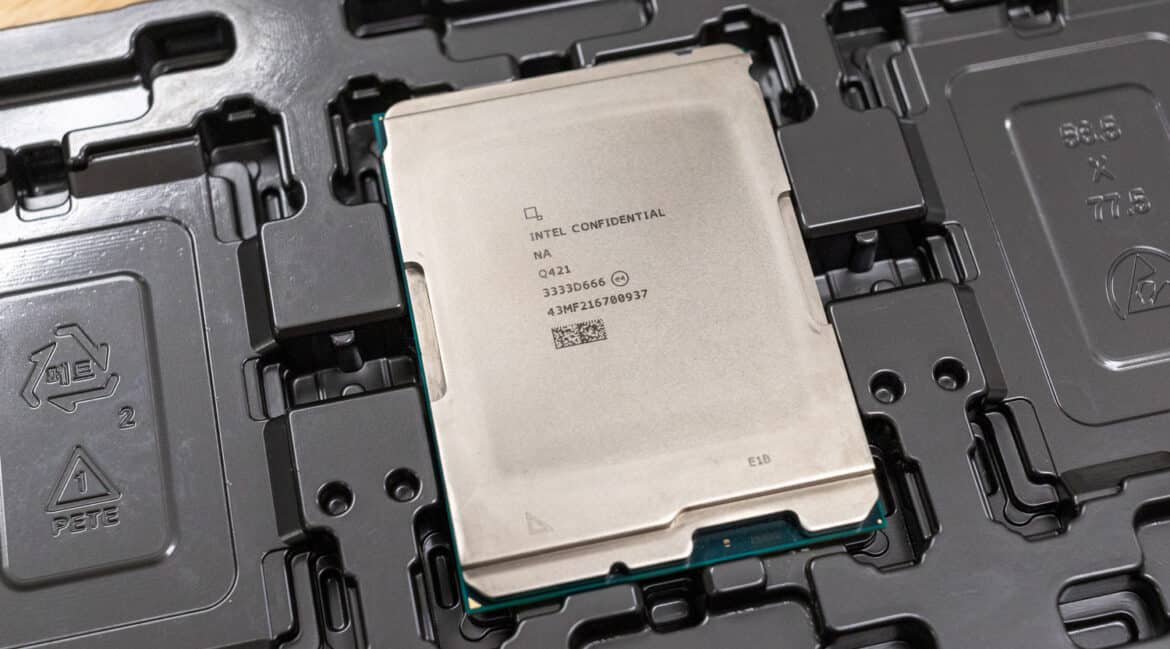5th Gen Intel Xeon Scalable Processors are ideally positioned for various applications thanks to enhanced performance and energy efficiency.
The 5th Gen Intel Xeon Scalable Processors are here, offering up to 64 cores per CPU and enhancing multi-threading and parallel processing capabilities. It features up to 5600 MT/s memory speed for faster data access and processing and up to triple the amount of shared Last Level Cache, increasing to 320 MB, which aids in faster data retrieval and improved efficiency. It also supports Type 3 memory with Compute Express Link 1.1, enhancing memory flexibility and performance.
5th Gen Intel Xeon Scalable Processor Line Features
The 5th Gen shows a substantial improvement over the 4th Gen Xeon processors. For example, Intel claims a 1.21x average performance gain overall, making it more efficient for diverse workloads. In specific areas like AI inference, there’s a potential improvement of up to 1.42x, while High-Performance Computing (HPC) applications could see up to a 1.4x performance gain. These processors achieve up to 1.7x higher throughput, enhancing efficiency and speed in data handling and processing tasks.
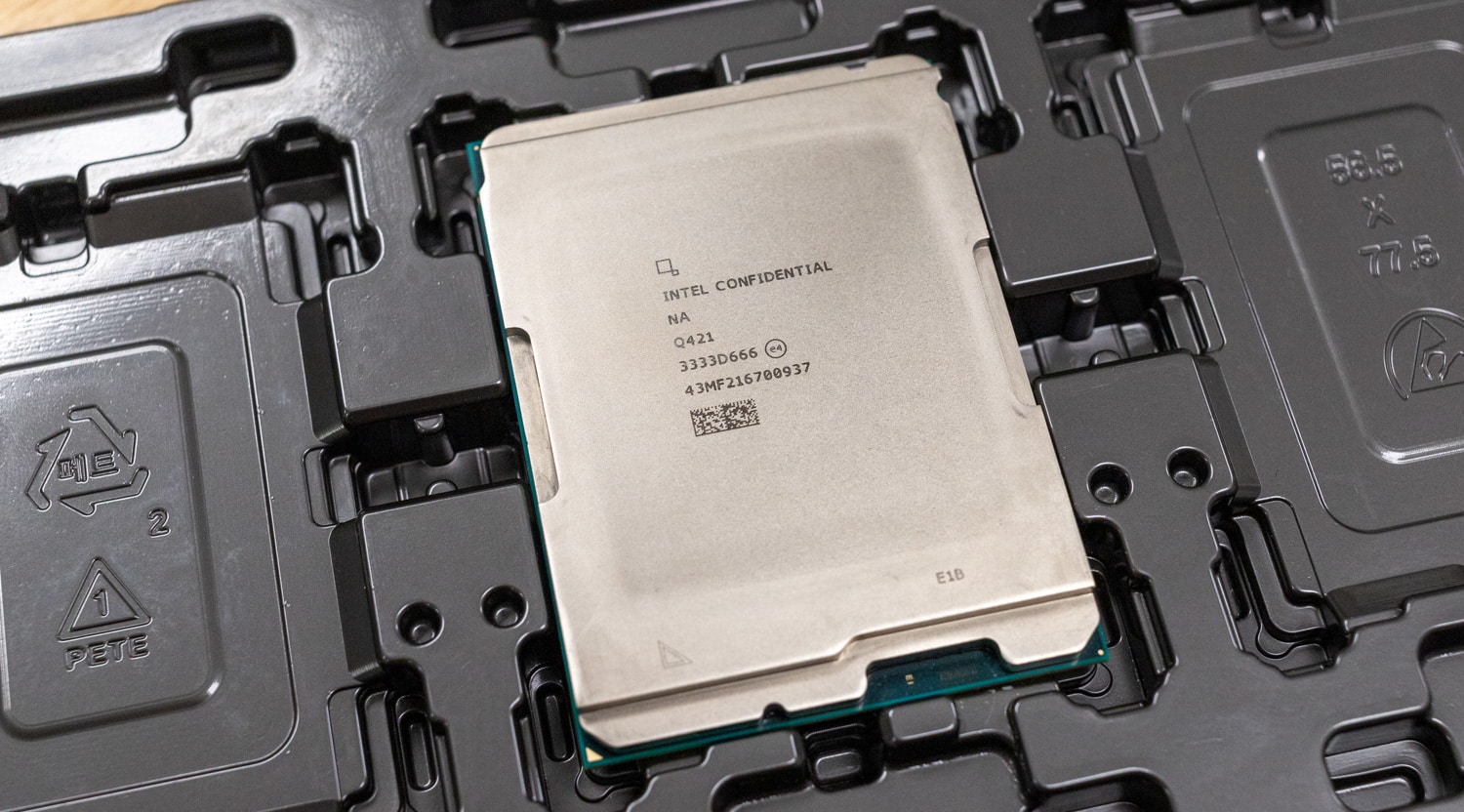
Moreover, The 5th Gen Intel Xeon processors come in different die packages to cater to various computing needs. The XCC package offers up to 64 cores, providing the highest performance for the most demanding tasks. With a single monolithic die, the MCC package supports up to 32 cores, balancing performance and power efficiency. The EE LCC package (a single monolithic die) offers up to 20 cores, making it ideal for energy-efficient solutions in less intensive computing environments.

Processor clustering modes in the XCC package include SNC2 and Hemi, with SNC3 as the default setting, allowing for efficient data processing and task distribution. The MCC package includes supported modes of SNC2 and Hemi, with Hemi as the default. These modes enable the processors to efficiently handle complex tasks by optimizing the distribution of workloads across different cores and cache hierarchies, enhancing overall system performance.

The processor line also emphasizes energy efficiency. It combines improved core and SOC interconnect power efficiency with a process revision update. As a result, Intel quotes a 1.34x higher average package performance per watt compared to the previous generation. It saves approximately 100W per socket at idle, offering substantial energy savings. The enhanced SOC interconnect frequency tuning, and the Active Idle Mode and Optimized Power Mode contribute to reduced power and cooling costs. This efficiency is especially notable at 30-40% utilization levels, where it can save up to 110W of server power.
Intel 5th Gen Xeon Processors – Turbo Frequencies
Intel’s 5th Gen Xeon Processors significantly improve Turbo Frequencies for various instruction sets. The enhancement is particularly notable in instruction classes such as SSE, AVX2, AVX512, and AMX, catering to different computational intensities like light, moderate, and heavy. These advancements ensure higher performance, especially in AVX-512 heavy and AMX light workloads. Furthermore, the processors exhibit a reduced Turbo frequency penalty when utilizing AVX512 or AMX instructions, expanding their applicability and efficiency.
Here is a breakdown of the improvements over the 4th Gen Xeon Processors:
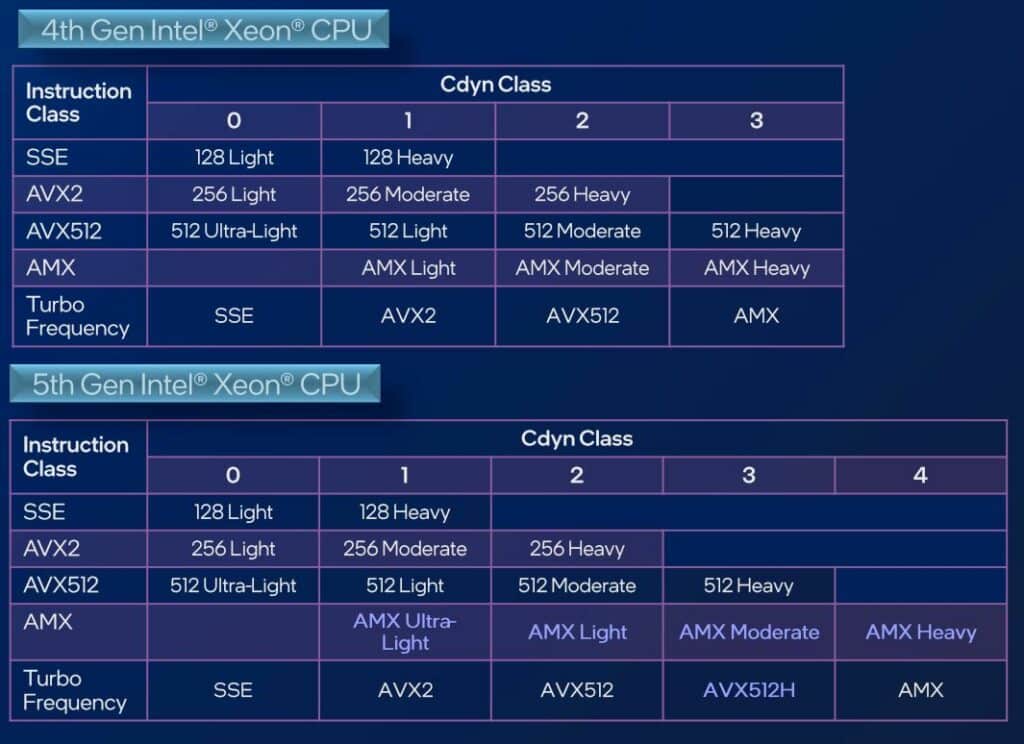
5th Gen Intel Xeon Scalable Processor Line SKUs
All of these advancements in the new Intel Xeon line certainly set the stage for a noticeable boost in performance and efficiency. The 5th Gen Intel Xeon Scalable Processors are divided into several categories, each tailored for specific performance needs and computing environments, so let’s look at the diverse range of available SKUs.
The “2S Performance – General Purpose” category offers a range of SKUs designed for high-performance tasks. These include the top-tier 8592+ with 64 cores, a base frequency of 1.9 GHz, and a turbo boost up to 3.9 GHz, priced at $11,600. The series extends to the 5515+ model with eight cores, offering a higher base frequency of 3.2 GHz and a turbo boost of 4.1 GHz while being priced much more affordably at $1,099. This category caters to varying levels of intensive computing needs, balancing core count, frequency, and price.
| SKU | Cores | Base (GHz) | All-core Turbo (GHz) | Max Turbo (GHz) | Cache (MB) | TDP (Watts) | DDR5 Memory Speed (1DPC) | Intel SGX Enclave capacity (per processor) | Long life availability | Pricing (USD) |
| 8592+ | 64 | 1.9 | 29 | 3.9 | 320 | 350 | 5600 | 512GB | No | $11,600 |
| 8580 | 60 | 2.0 | 29 | 4.0 | 300 | 350 | 5600 | 512GB | No | $10,710 |
| 8570 | 56 | 2.1 | 3.0 | 4.0 | 300 | 350 | 5600 | 512GB | No | $9,595 |
| 8568Y+ | 48 | 2.3 | 3.2 | 4.0 | 300 | 350 | 5600 | 512GB | No | $6,497 |
| 8562Y+ | 32 | 2.8 | 3.8 | 4.1 | 60 | 300 | 5600 | 512GB | No | $5,945 |
| 6548Y+ | 32 | 2.5 | 3.5 | 4.1 | 60 | 250 | 5200 | 128GB | Yes | $3,726 |
| 6542Y | 24 | 2.9 | 3.6 | 4.1 | 60 | 250 | 5200 | 128GB | No | $2,878 |
| 6544Y | 16 | 3.6 | 4.1 | 4.1 | 45 | 270 | 5200 | 128GB | No | $3,622 |
| 6526Y | 16 | 2.8 | 3.5 | 3.9 | 37.5 | 195 | 5200 | 128GB | Yes | $1,517 |
| 6534 | 8 | 3.9 | 4.2 | 4.2 | 22.5 | 195 | 4800 | 128GB | No | $2,816 |
| 5515+ | 8 | 3.2 | 3.6 | 4.1 | 22.5 | 165 | 4800 | 128GB | Yes | $1,099 |
The “2S Mainline – General Purpose” category of the 5th Gen Intel Xeon line includes a variety of SKUs designed for versatile enterprise applications. This range features processors like the 8558, with 48 cores and a base frequency of 2.1 GHz, and extends to lower-grade models like the 4509Y, an 8-core processor with a higher base frequency of 2.6 GHz. These processors are priced from around $563 to $4,650, reflecting their varied core count, frequency, and cache size capabilities, making them suitable for a broad spectrum of general-purpose computing tasks.
| 2S Mainline – General Purpose | ||||||||||
| SKU | Cores | Base (GHz) | All Core Turbo (GHz) | Max Turbo (GHz) | Cache (MB) | TDP (Watts) | DDR5 Memory Speed (1DPC) | Intel SGX Enclave Capacity (per processor) | Long Life Availability | Pricing (USD) |
| 8558 | 48 | 2.1 | 3.0 | 4.0 | 260 | 330 | 5200 | 512GB | No | $4,650 |
| 6538Y+ | 32 | 2.2 | 3.3 | 4.0 | 60 | 225 | 5200 | 128GB | No | $3,141 |
| 6530 | 32 | 2.1 | Z7 | 4.0 | 160 | 270 | 4800 | 128GB | Yes | $2,128 |
| 5520+ | 28 | 2.2 | 3.0 | 4.0 | 5Z5 | 205 | 4800 | 128GB | Yes | $1,640 |
| 4516Y+ | 24 | 2.2 | 2.9 | 3.7 | 45 | 185 | 4400 | 64GB | Yes | $1,295 |
| 4514Y | 16 | 2.0 | 2.6 | 3.4 | 30 | 150 | 4400 | 64GB | Yes | $780 |
| 4510 | 12 | 2.4 | 3.3 | 4.1 | 30 | 150 | 4400 | 64GB | Yes | $563 |
| 4509Y | 8 | 2.6 | 3.6 | 4.1 | 22.5 | 125 | 4400 | 64GB | Yes | $563 |
Processors in the “Liquid-cooled – General Purpose” category are designed for environments where efficient heat management is crucial. It includes the high-end 8593Q model with 64 cores, a base frequency of 2.2 GHz, and a TDP of 385 Watts, priced at $12,400. The only other SKU is the 6558Q, offering 32 cores with a higher base frequency of 3.2 GHz and a TDP of 350 Watts, priced at $6,416. These liquid-cooled processors are particularly suited for data centers where maintaining optimal operating temperatures is critical.
| Liquid-cooled – General Purpose | ||||||||||
| SKU | Cores | Base (GHz) | All- Core Turbo (GHz) | Max Turbo (GHz) | Cache (MB) | TDP (Watts) | DDR5 Memory Speed (1DPC) | Intel SGX Enclave Capacity (per processor) | Long Life Availability | Pricing (USD) |
| 8593Q | 64 | 2.2 | 3.0 | 3.9 | 320 | 385 | 5600 | 512GB | No | $12,400 |
| 6558Q | 32 | 3.2 | 4.1 | 4.1 | 60 | 350 | 5200 | 128GB | No | $6,416 |
The “Single socket – General Purpose” category is designed for efficient performance in single-socket server environments. Only three SKUs are included here, including the 855BU with 48 cores and a TDP of 300 Watts, priced at $3,720, and the 5512U with 28 cores and a TDP of 185 Watts, priced at $1,230. These processors are optimized for tasks requiring fewer cores but high efficiency, making them ideal for smaller servers and applications where energy efficiency is a priority.
| Single socket – General Purpose | ||||||||||
| SKU | Cores | Base (GHz) | All Core Turbo (GHz) | Max Turbo (GHz) | Cache (MB) | TDP (Watts) | DDR5 Memory Speed (1DPC) | Intel SGX Enclave Capacity (per processor) | Long Life Availability | Pricing (USD) |
| 855BU | 48 | 2.0 | 2.9 | 4.0 | 260 | 300 | 4800 | 512GB | No | $3,720 |
| 5512U | 28 | 2.1 | 3.0 | 3.7 | 525 | 185 | 4800 | 128GB | No | $1,230 |
| 35O8U | 8 | 2.1 | 2.2 | 2.2 | 225 | 125 | 4400 | 64GB | No | $415 |
The “5G/Networking optimized (-N)” category of the 5th Gen Intel Xeon Scalable Processor line focuses on networking and telecommunications needs. The 857W and 6538N/6538N models, with core counts of 52 and 32, respectively, offer high connectivity options, making them ideal for 5G and data communication tasks. These processors balance high core performance with networking optimization, providing solutions for the increasing demands of modern network infrastructures.
| 5G/Networking optimized (-N) | ||||||||||
| SKU | Cores | Base (GHz) | All Core Turbo (GHz) | Max Turbo (GHz) | Cache (MB) | TDP (Watts) | DDR5 Memory Speed (1DPC) | Intel SGX Enclave Capacity (per processor) | Long Life Availability | Pricing (USD) |
| 857W | 52 | 2.4 | 3.0 | 4.0 | 300 | 300 | 4800 | 512GB | Yes | $6,839 |
| 6548N | 32 | 2.8 | 3.5 | 4.1 | 60 | 250 | 5200 | 128GB | Yes | $3,875 |
| 6538N | 32 | 2.1 | 2.9 | 4.1 | 60 | 205 | 5200 | 128GB | Yes | $3,351 |
The “Cloud Optimized laaS(-P) / SaaS(-V)” category is tailored for cloud infrastructures. It includes the high-end SKU 8592V with 64 cores and advanced memory capabilities, ideal for demanding cloud applications and services. These processors are designed to deliver optimized performance for Infrastructure-as-a-Service (IaaS) and Software-as-a-Service (SaaS), ensuring efficient cloud computing solutions.
| Cloud Optimized laaS(-P) / SaaS(-V) | ||||||||||
| SKU | Cores | Base (GHz) | All Core Turbo (GHz) | Max Turbo (GHz) | Cache (MB) | TDP (Watts) | DDR5 Memory Speed (1DPC) | Intel SGX Enclave Capacity (per processor) | Long Life Availability | Pricing (USD) |
| 8592V | 64 | 2.0 | 2.9 | 3.9 | 320 | 330 | 4800 | 512GB | No | $10,995 |
| 8558P | 48 | Z7 | 3.2 | 4.0 | 260 | 350 | 5600 | 512GB | No | $6,759 |
| 8581V | 60 | 2.0 | 2.6 | 3.9 | 300 | 270 | 4800 | 512GB | No | $7,568 |
The “Storage & Hyperconverged Infrastructure (HCI) Optimized (-S)” category, represented by SKUs like the 6554S, is designed for storage-intensive and HCI environments, offering balanced performance for data-centric tasks. In contrast, the “Long-life Use (IOT) – General Purpose (-T)” category, with SKUs like the 4510T, is tailored for IoT applications requiring long-term reliability and efficient performance, catering to the unique demands of IoT infrastructures.
| Storage & Hyper-converged Infrastructure (HCI) Optimized (-S) | ||||||||||
| SKU | Cores | Base (GHz) | All Core Turbo (GHz) | Max Turbo (GHz) | Cache (MB) | TDP (Watts) | DDR5 Memory Speed (1DPC) | Intel SGX Enclave Capacity (per processor) |
Long Life Availability | Pricing (USD) |
| 6554S | 36 | 22 | 3.0 | 4.0 | 180 | 270 | 5200 | 128GB | No | $3,157 |
| Long-life Use (IOT) – General Purpose (-T) | ||||||||||
| 4510T | 12 | 2.0 | 2.8 | 3.7 | 30 | 115 | 4400 | 64GB | Yes | $624 |
Intel 5th Generation Xeon E-2400 Series
The Intel 5th Generation Xeon E-2400 series (introduced on November 30, 2023) is also available, representing a significant advancement in technology for entry-level servers. Targeted toward small and medium businesses, these processors offer enhanced performance and efficiency for various applications. Available with 8-, 6-, and 4-core configurations, the E-2400 series is designed for entry-level cloud hosting and SMB applications, particularly in areas such as Enterprise Resource Planning (ERP), customer relationship management (CRM), and database management.
The E-2400 series performs up to 1.3 times better than previous generations, with higher frequencies reaching up to 5.6GHz, enabled by Intel Turbo Boost Max Technology 3.0. This technology ensures optimal performance under demanding workloads. The processors support 16 lanes of PCIe 5.0 for faster data transfer and improved system expansion capabilities. Memory support includes up to 128 GB of DDR5 memory at 4800 MT/s with ECC, offering speed and reliability. Additionally, these processors deliver server-grade reliability and manageability, essential for SMBs dependent on consistent and efficient server operation.
Intel 5th Generation Xeon E-2400 Series Specifications
| Feature | Specification |
| Maximum Core Count | Up to 8 Cores |
| Maximum Base Frequency | 3.5 GHz |
| Maximum Turbo Boost 3.0 Frequency | 5.6 GHz |
| Cache Memory | Up to 24 MB Intel Smart Cache |
| Performance Technologies | Intel Turbo Boost Max Technology 3.0, Intel Hyper-Threading Technology |
| Number of Processor Sockets | One Socket |
| Thermal Design Point (TDP) | Up to 95 Watts |
| Socket Type | LGA1700 Socket |
| System Memory Support | 2 channels of DDR5 ECC, Up to 4800 MT/s, 2 DPC, UDIMMs only |
| Maximum System Memory | Up to 128 GB |
| Supported Chipset | Intel C262 or C266 Chipsets |
| I/O Specifications | PCI Express 5.0 – Up to 16 lanes (CPU), PCI Express 4.0 – Up to 20 lanes (PCH), USB 3.2 Gen2x2 (20G) – Up to 5 ports, USB 3.2 Gen2x1 (10G) – Up to 10 ports, SATA 3.0 – Up to 8 ports, DMI – 8 lanes, Gen 4 |
| Server Platform Services | Intel SPS 6.0 with Intel NM support |
| Intel VROC | SATA RAID |
| Support for Intel Ethernet | 1 GbE 1210 (LOM/AIC), 10 GbE x710 (AIC), 25 GbE E810 (AIC) |
| Manufacturing Process | Intel 7 process technology |
Seamless Upgrade: 5th Gen Xeon Scalable Processors on 4th Gen Platforms
With the rollout of 5th Generation Xeon Scalable Processors, Intel is emphasizing its drop-in compatibility with 4th Generation Xeon platforms. We tested this in our lab with the Supermicro Hyper SuperServer and the SuperBlade x13 platforms.
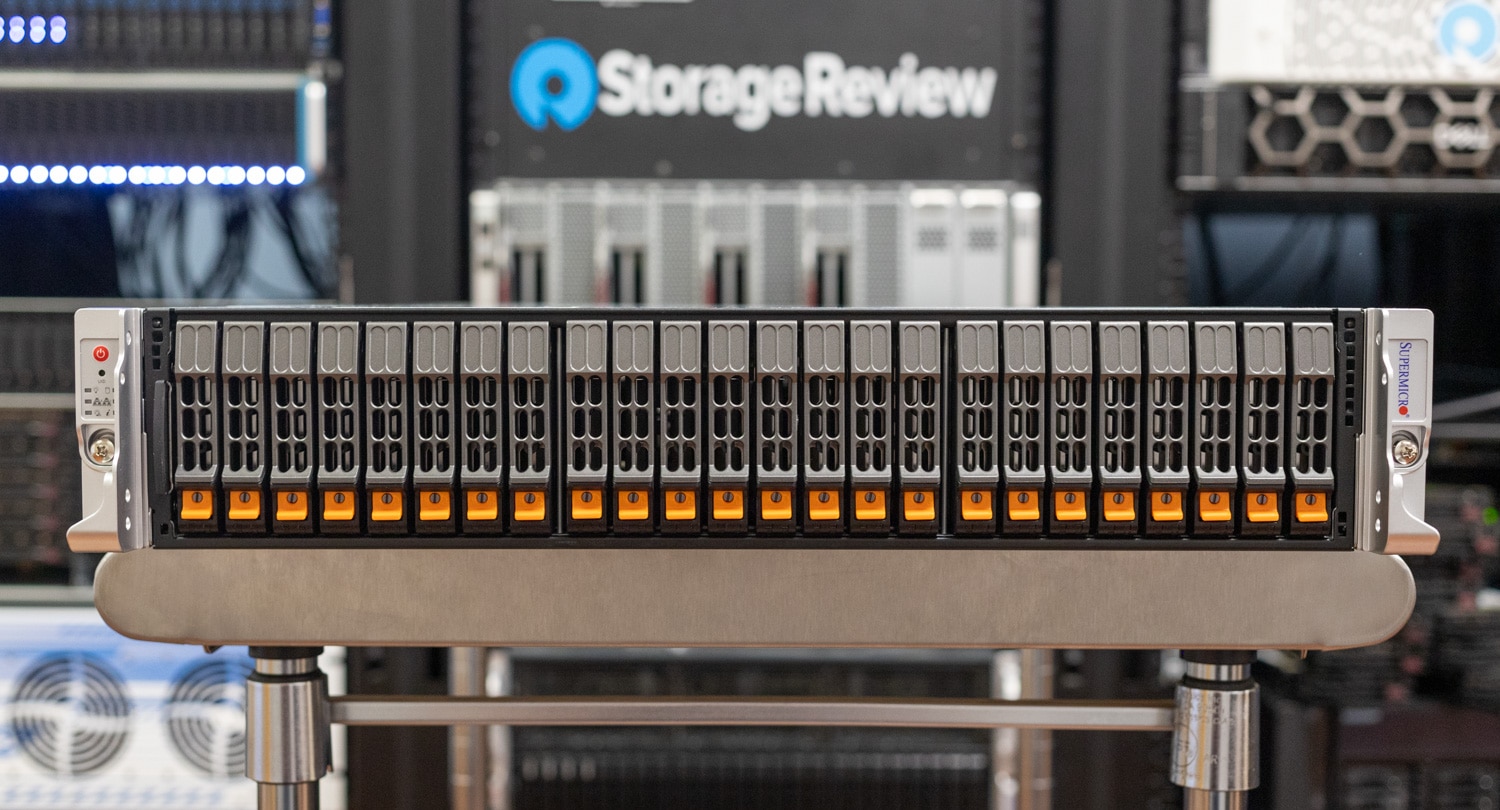
Supermicro Hyper SuperServer Specifications:
- Supermicro SYS-221H-TN24R
- 2 x Intel Xeon 8562Y+ CPUs
- 1TB of DDR5 RAM
- Windows Server 2022
Supermicro SuperBlade Specifications:
- Supermicro SBI-411E-5G
- 1 x Intel Xeon 8562Y+ CPU
- 256GB of DDR5 RAM
- Windows Server 2022
Here’s the scoop: upgrading to the 5th Gen Xeon is almost ridiculously easy. However, it required one minor tweak – swapping out the CPU retaining bracket. This unassuming piece of plastic is the only difference to ensure that the processor fits snuggly against the heat sink for optimal thermal management.
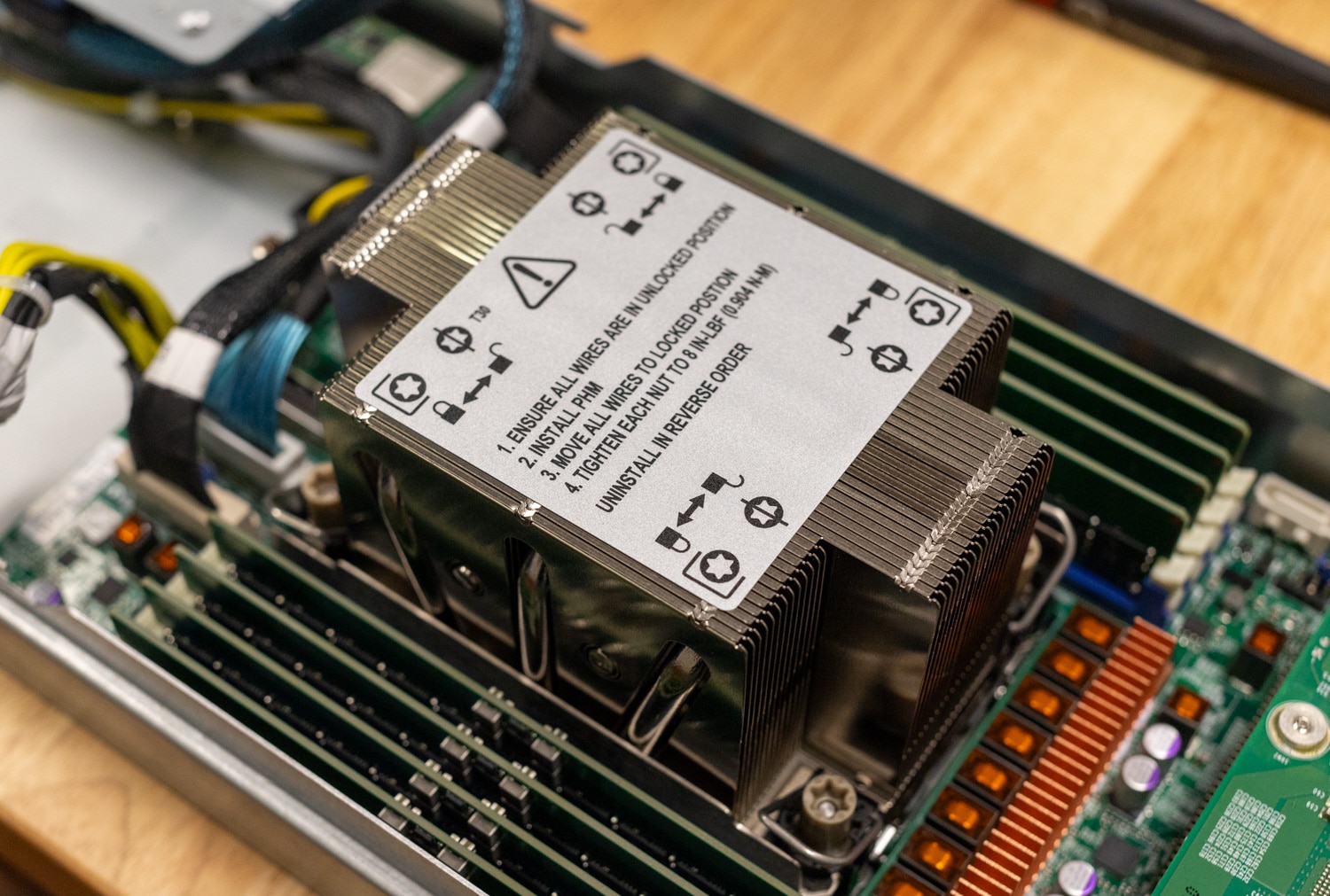
Upgrading the SuperBlade x13 was the highlight of our experiment. Known for its dense computing and customization, the SuperBlade x13 was straightforward, requiring only a BIOS update provided by the team at Supermicro. The update was point-and-click easy through the BMC. This enabled the motherboard to boot with all the new processors’ capabilities. Updating and managing all of the blades through the blade chassis management made the process almost like playing a video game version of being a data center tech.
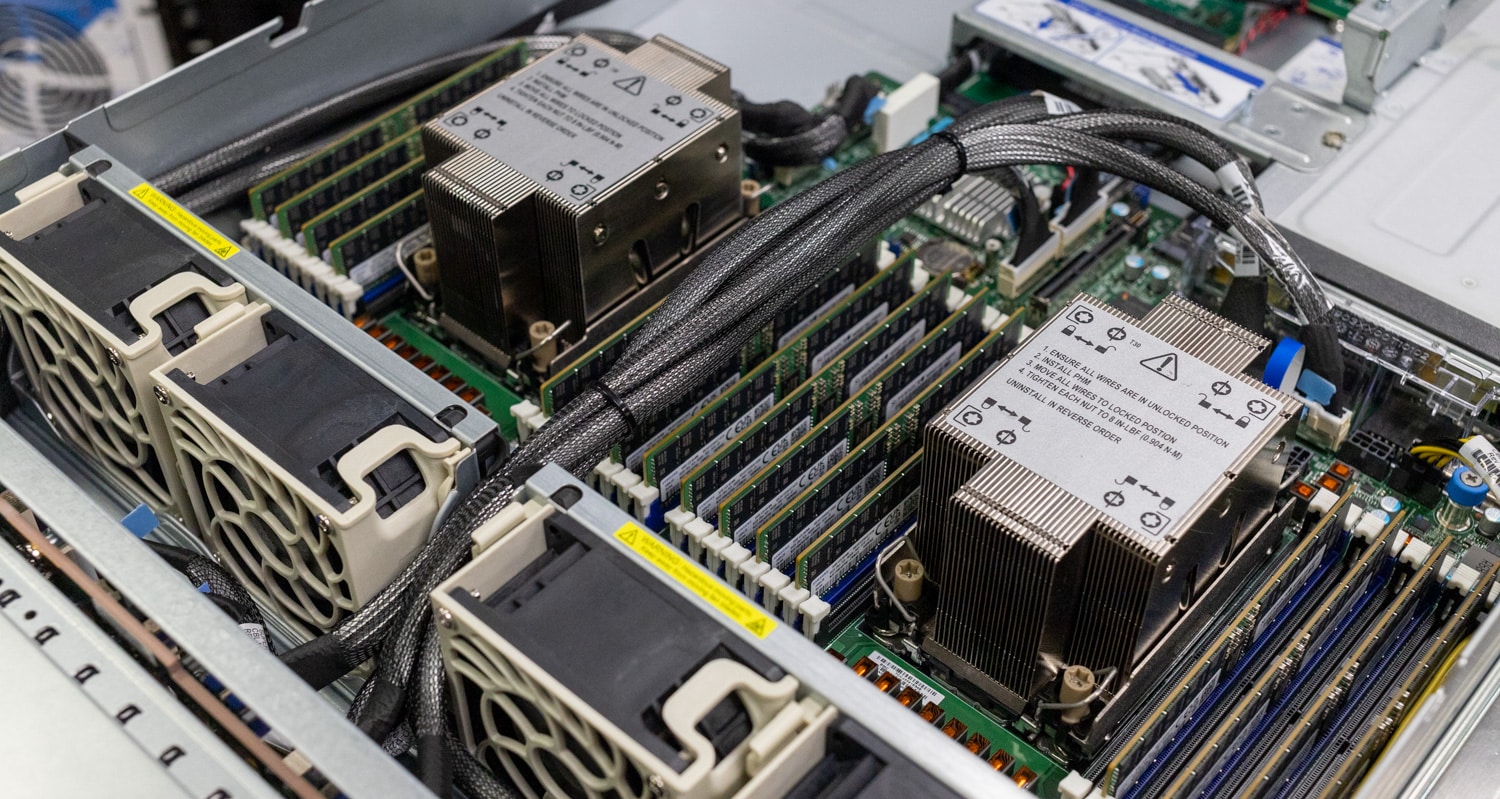
Intel promises a noticeable jump in performance, energy efficiency, and system stability demanded in high-density computing like the SuperBlade. This upgrade has effectively turbocharged our SuperBlade x13 platform, as demonstrated by the basic benchmarks below, and we are working through long-term, more complex testing with the new CPUs.
Performance
For launch day, we had a set of 32-core Xeon Platinum 8562Y+ CPUs in the lab. We were able to test these mid-tier chips in a 2P configuration.
Blender OptiX
First up is the Blender test–an open-source 3D modeling application. This benchmark was run using the Blender Benchmark utility. The score is samples per minute, with higher being better.
In the benchmark tests for version 3.6 of Blender.
| Blender 3.6 CPU | 2x 32c64t 8562Y+ |
| Monster | 841.118088 |
| Junkshop | 516.045803 |
| Classroom | 410.40804 |
In version 4.0 of Blender.
| Blender 4.0 CPU | 2X 32c64t 8562Y+ |
| Monster | 805.254137 |
| Junkshop | 513.800608 |
| Classroom | 414.999628 |
Blackmagic RAW Speed Test
We have also started running Blackmagic’s RAW speed test, which tests video playback performance. Additionally, this test is more of a hybrid test pooling both CPU and GPU in a Real-World scenario for RAW decoding.
| Blackmagic RAW Speed Test | 2x 32c64t 8562Y+ |
| 8k CPU | 175 FPS |
Geekbench 6
Geekbench 6 is a cross-platform benchmark that measures overall system performance. However, looking at the single-core vs. multi-core and the OpenCL benchmark would be interesting. Higher scores are better. Again, we only looked at the CPU results, as no GPU is installed inside this server.
| Geek Bench 6 | 2x 32c64t 8562Y+ |
| Single Core | 2149 |
| Multi Core | 22494 |
You can find comparisons to any system you want in the Geekbench Browser.
Cinebench R23
Maxon’s Cinebench R23 is a CPU rendering benchmark that utilizes all CPU cores and threads. We ran it for both multi- and single-core tests. Higher scores are better.
| Cinebench R23 | 2x 32c64t 8562Y+ |
| CPU Multi Core | 103,848 |
| CP Single Core | 1,500 |
| MP Ratio | 69.25x |
Cinebench 2024
Here are the results for the 2024 version of Cinebench, looking at the CPU.
| Cinebench R24 | 2x 32c64t 8562Y+ |
| CPU Multi Core | 5,289 |
| CP Single Core | 82 |
| MP Ratio | 62.1 |
y-cruncher
y-cruncher is a multi-threaded and scalable program that can compute Pi and other mathematical constants to trillions of digits. Since its launch in 2009, y-cruncher has become a popular benchmarking and stress-testing application for overclockers and hardware enthusiasts. Faster is better in this test.
| y-cruncher | 2x 32c64t 8562Y+ |
| 50 Billion | 363.758 seconds |
| 25 Billion | 164.066 seconds |
| 10 Billion | 57.868 seconds |
| 5 Billion | 26.934 seconds |
| 2.5 Billion | 12.036 seconds |
| 1 Billion | 4.344 seconds |
7-Zip Compression
The built-in memory benchmark in the popular 7-Zip utility demonstrates the CPU performances of each machine well. We run this test at a 128MB dictionary size when possible.
| 7-Zip Compression Benchmark (Higher is better) | 2x 32c64t 8562Y+ | |
| Compressing | ||
| Current CPU Usage | 5,634% | |
| Current Rating/Usage | 5.138 GIPS | |
| Current Rating | 289.491 GIPS | |
| Resulting CPU Usage | 5,620% | |
| Resulting Rating/Usage | 5.140 GIPS | |
| Resulting Rating | 288.861 GIPS | |
| Decompressing | ||
| Current CPU Usage | 6,096% | |
| Current Rating/Usage | 4.753 GIPS | |
| Current Rating | 289.744 GIPS | |
| Resulting CPU Usage | 6,098% | |
| Resulting Rating/Usage | 4.798 GIPS | |
| Resulting Rating | 292.549 GIPS | |
| Total Rating | ||
| Total CPU Usage | 5,859% | |
| Total Rating/Usage | 4.969 GIPS | |
| Total Rating | 290.705 GIPS | |
Conclusion
The 5th Gen Intel Xeon Scalable Processors mark a significant evolution from their 4th generation predecessors, tailored for high-end server, workstation, and data center applications. These enterprise-grade processors, notable for their advanced multi-core processing, high memory capacity, and robust security features, now boast up to 64 cores per CPU, significantly enhancing multi-threading and parallel processing capabilities. They have memory speeds up to 5600 MT/s and a greatly expanded shared Last Level Cache of up to 320 MB. Incorporating Type 3 memory with Compute Express Link 1.1 further underscores their adaptability and performance, making this lineup well-suited for demanding and complex computing environments.
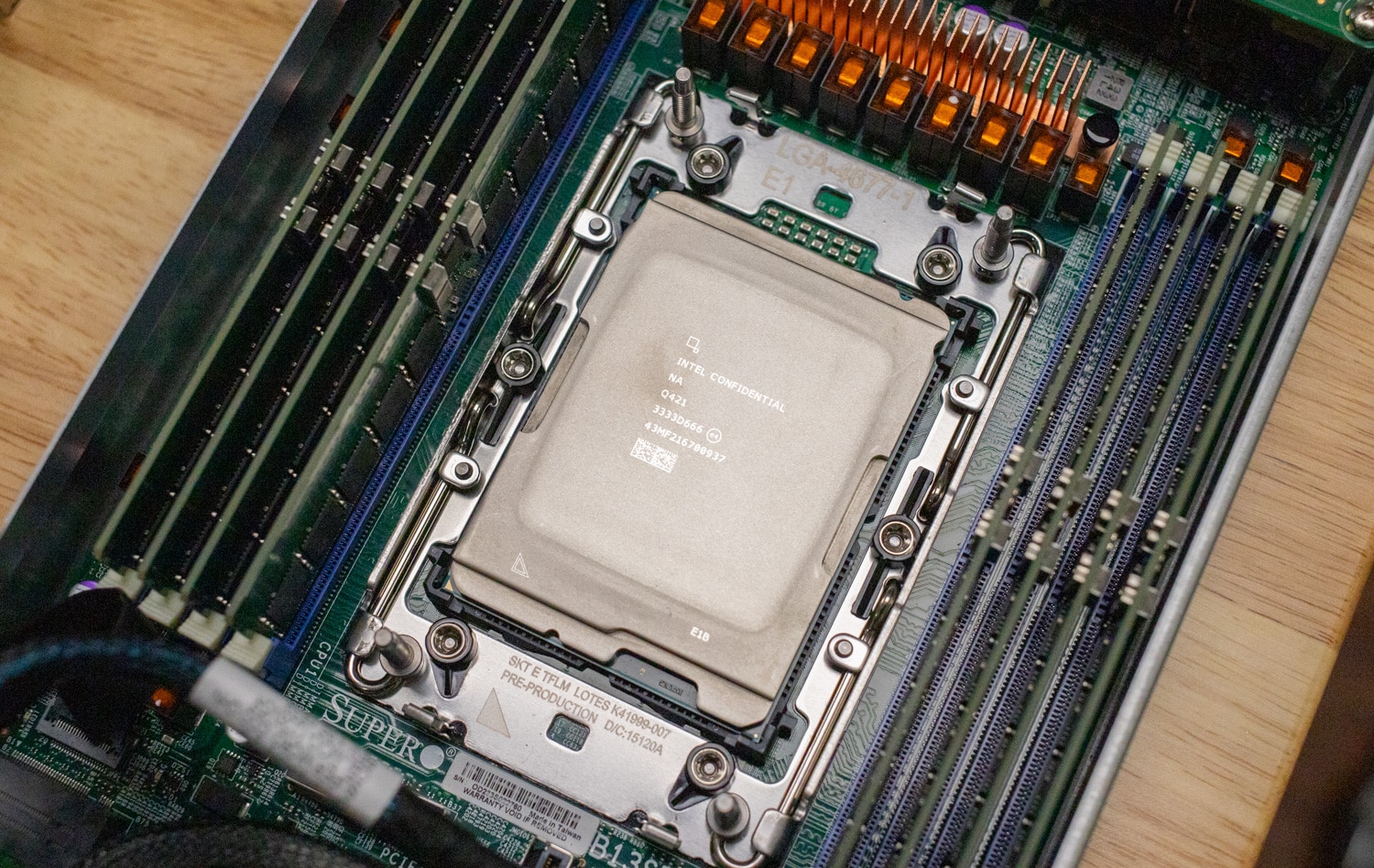
It’s worth mentioning that the transition from the 4th Gen chiplet design to the 5th Gen two-die architecture marks a pivotal shift in Intel’s approach to processor design. This change enables a more scalable and efficient layout, accommodating the increased core counts and enhanced cache capacities. The new die packages, including the XCC, MCC, and LCC, each offer different core counts and power efficiencies, indicating a nuanced approach to balancing performance, power consumption, and thermal dynamics. Introducing new processor clustering modes like SNC2 and Hemi optimizes workload distribution across cores and cache hierarchies, boosting overall system performance.
As such, the 5th Gen Intel Xeon Scalable Processors are ideally positioned for various applications. Their enhanced performance and energy efficiency make them suitable for demanding data centers, cloud computing, AI and machine learning tasks, and large-scale enterprise environments. Furthermore, the diverse range of SKUs, including variants optimized for liquid cooling, single-socket servers, 5G/networking, cloud infrastructures, storage, and hyper-converged infrastructure, certainly showcases their versatility. These processors are not only a fit for current high-demand computing requirements but are also future-proof solutions for emerging technologies and applications.
Engage with StorageReview

